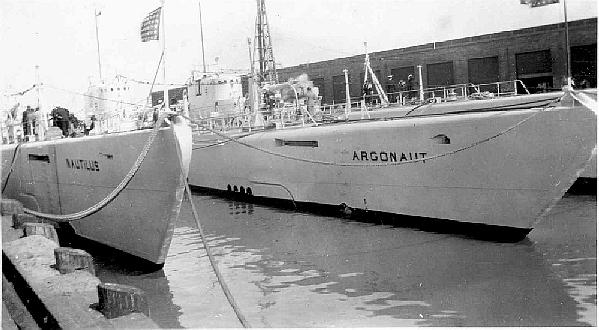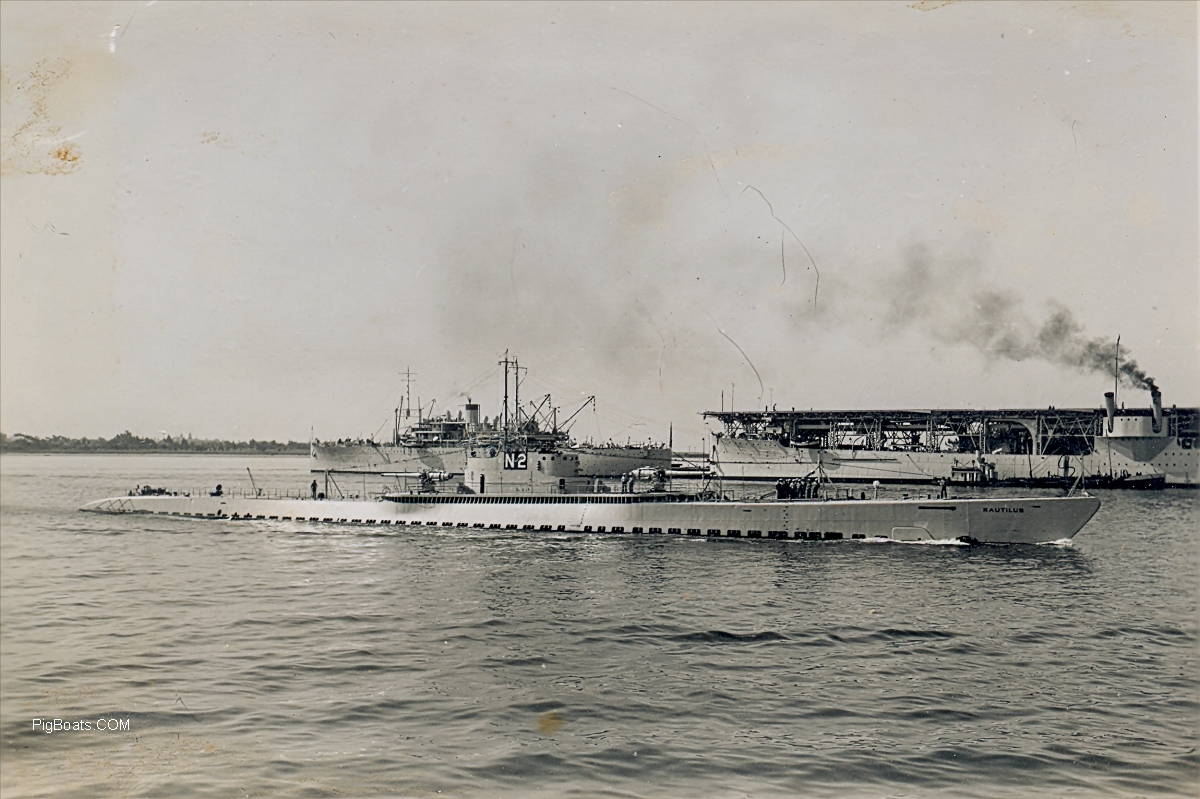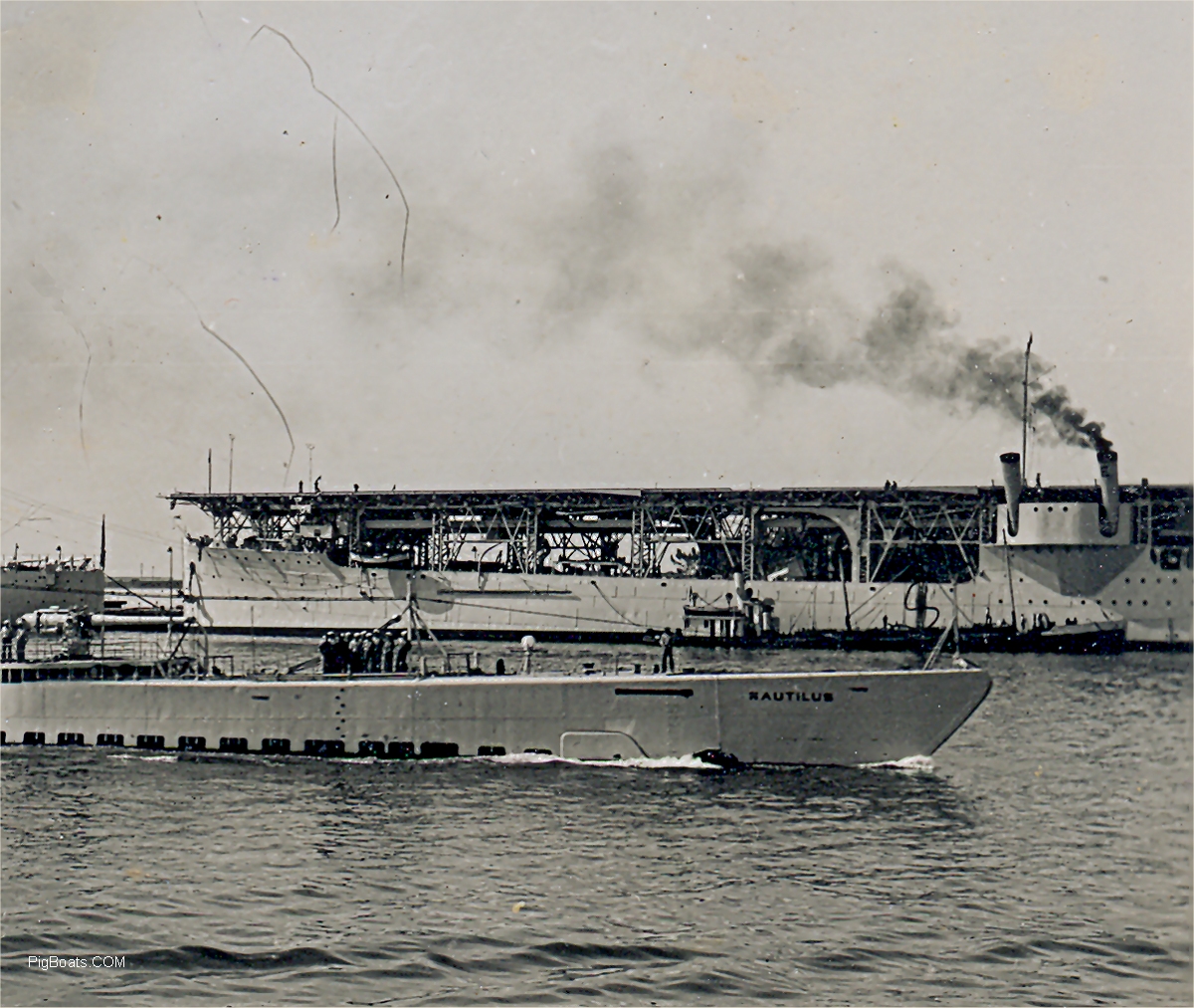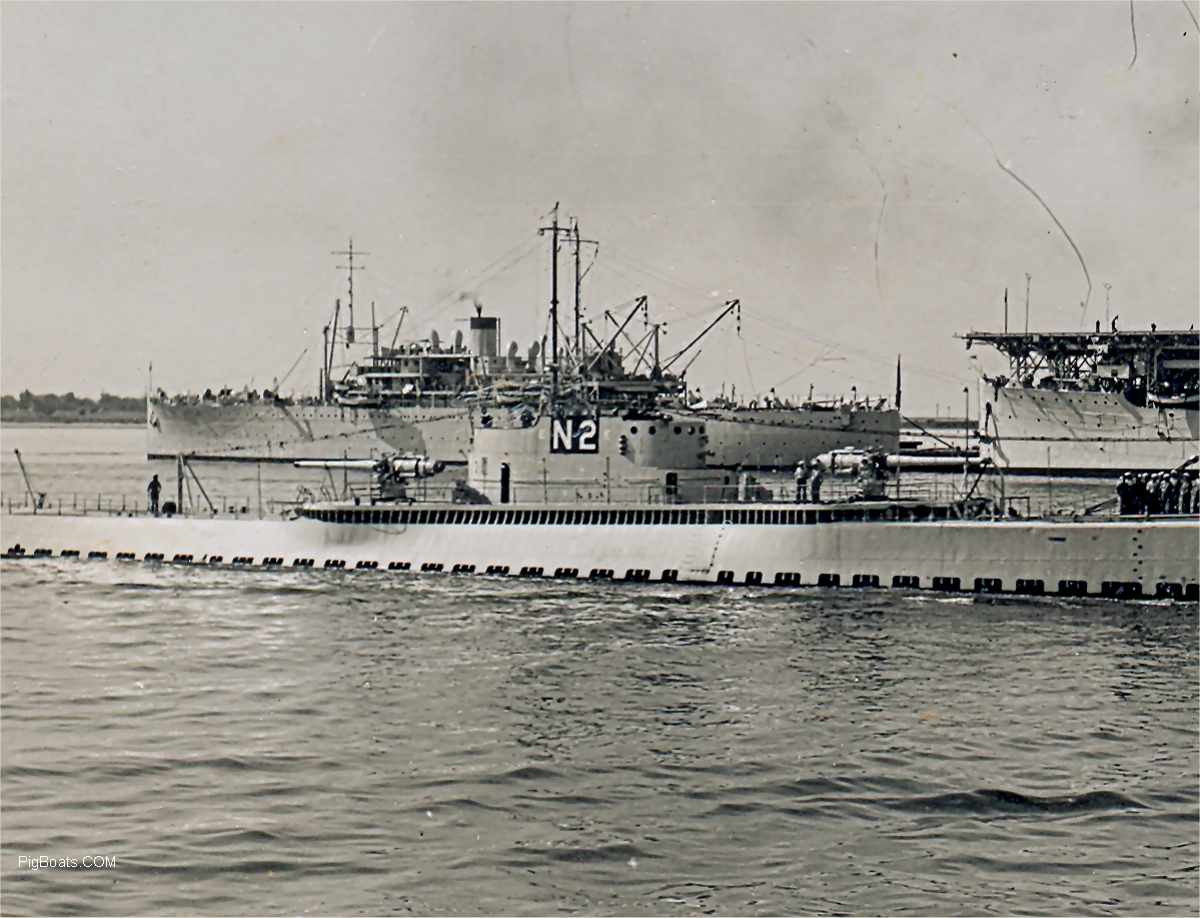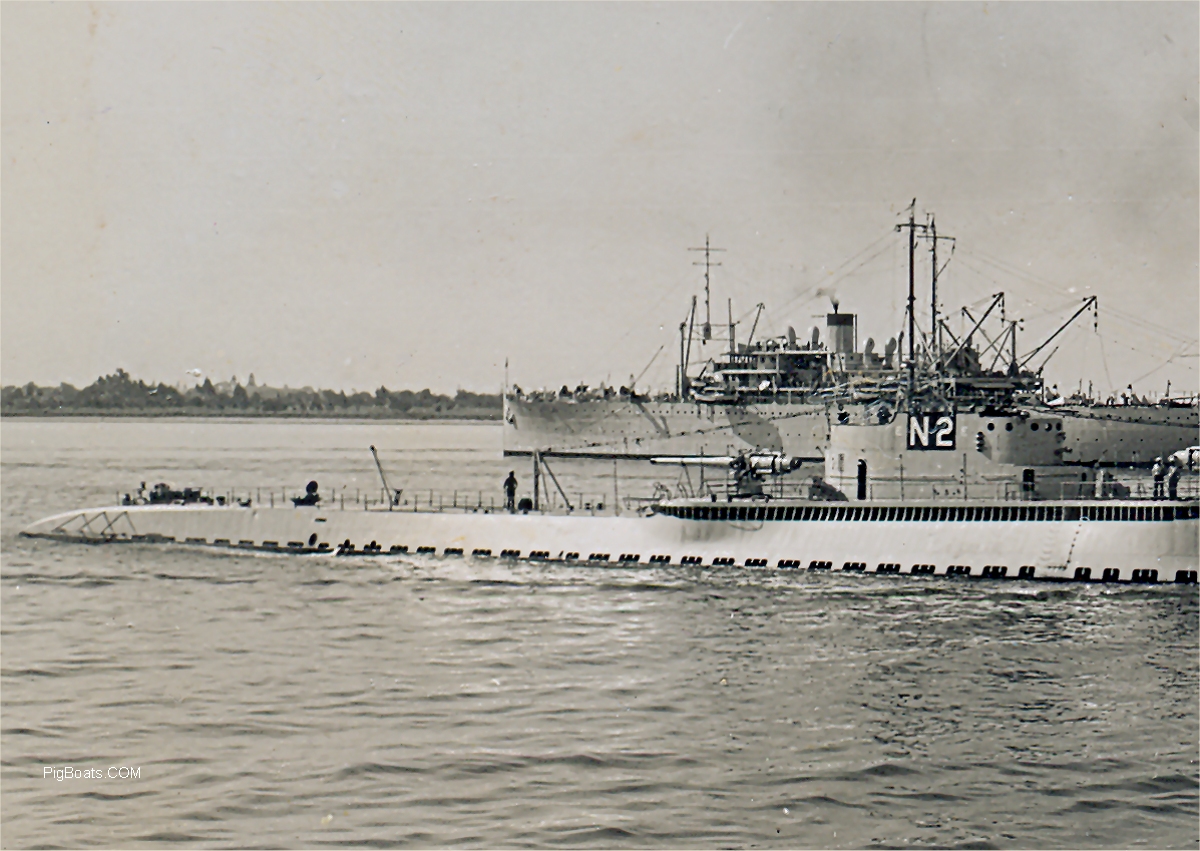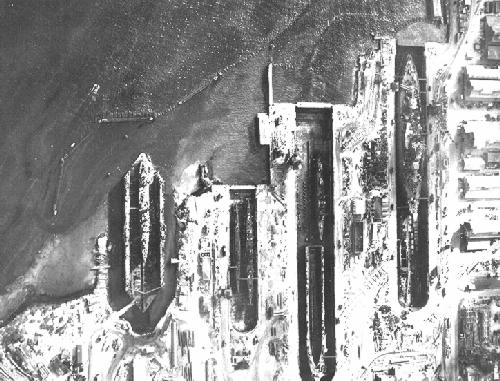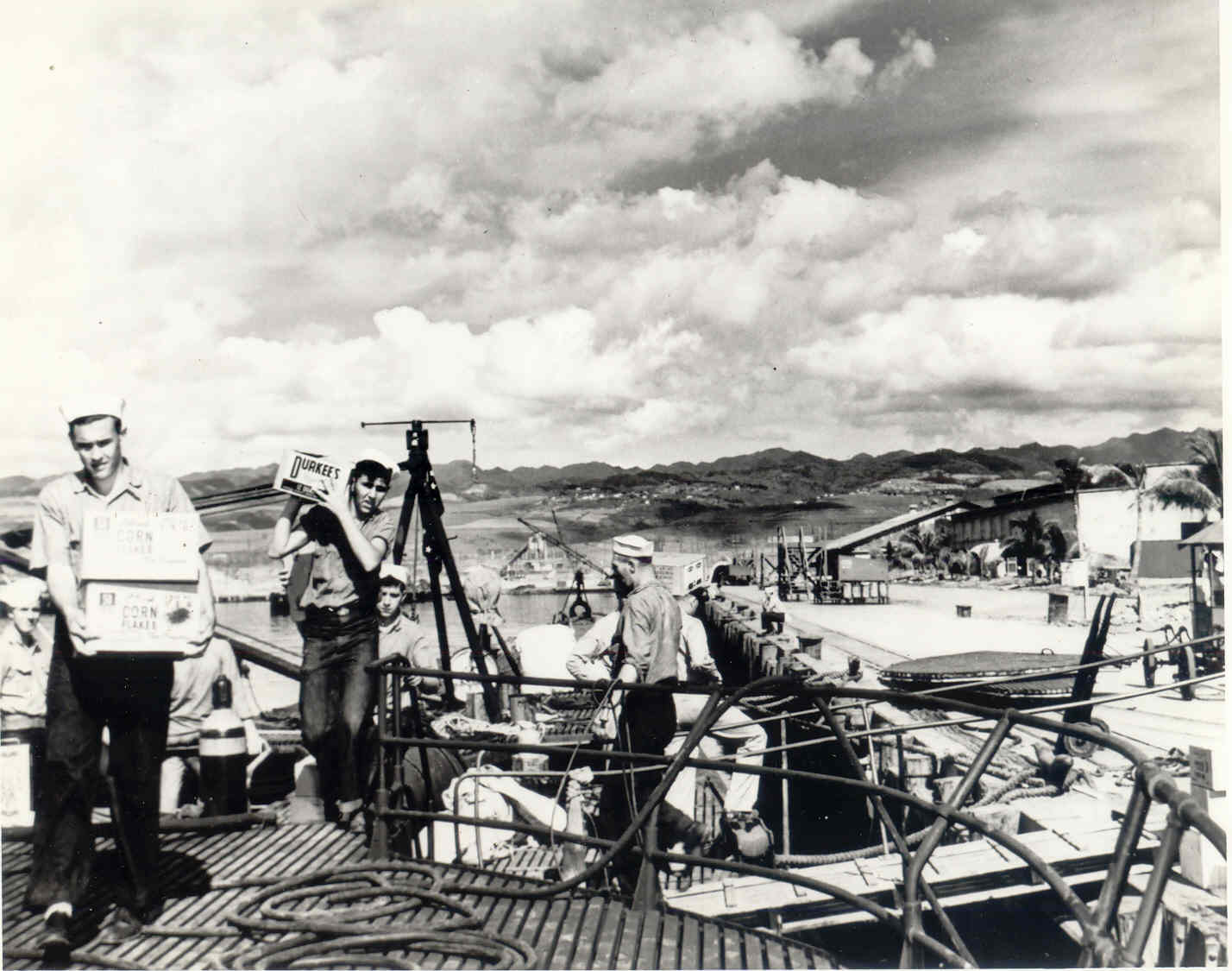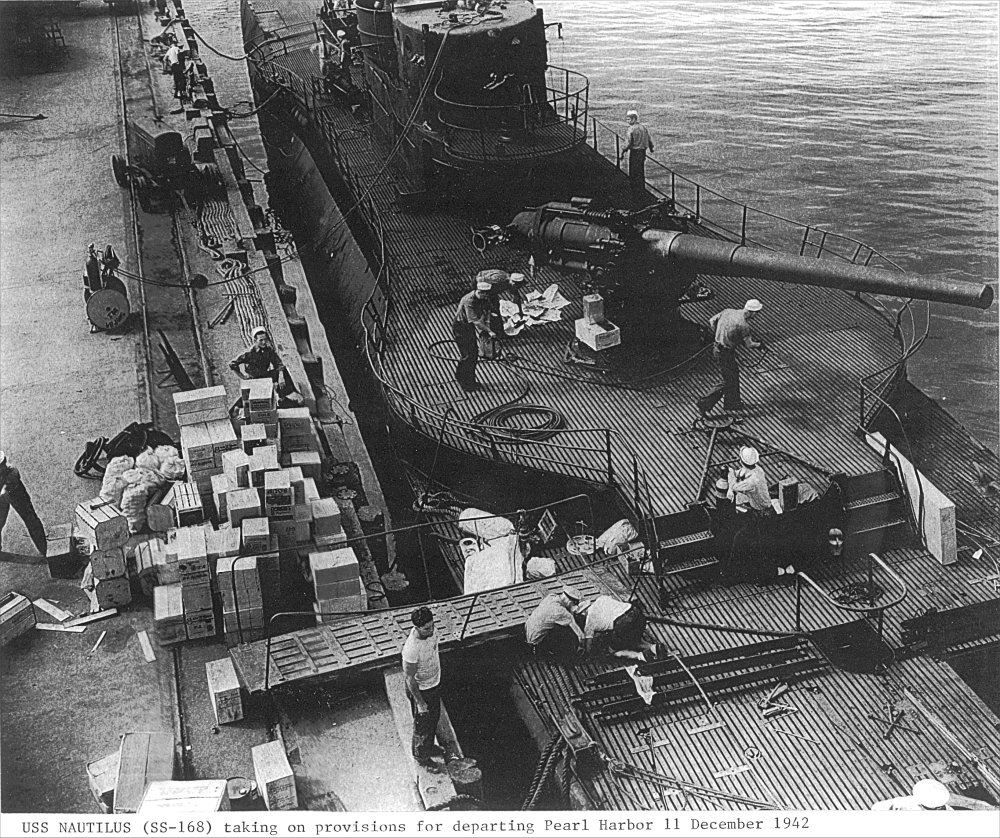168: Difference between revisions
Pbcjohnston (talk | contribs) Started photo formatting |
Pbcjohnston (talk | contribs) Added more photos |
||
| Line 2: | Line 2: | ||
[[File:Nautilus build-1.jpg|left|500px]] | [[File:Nautilus build-1.jpg|left|500px]] | ||
<div style="text-align: justify;"><span style="color:#00008B">Scaffolding being erected at Mare Island Navy Yard, Building Ways #2, Vallejo, California, April 14, 1927 in preparation for the start of construction for the V-6. The scaffolding in which the V-6 will be built is almost complete, even including the cofferdam around the stern since this portion extends down to the water level at the foot of the ways. You can see the water lifting pump and hoses to keep the cofferdam area water free at the photo's bottom. | <div style="text-align: justify;"><span style="color:#00008B">Scaffolding being erected at Mare Island Navy Yard, Building Ways #2, Vallejo, California, April 14, 1927 in preparation for the start of construction for the V-6. The scaffolding in which the V-6 will be built is almost complete, even including the cofferdam around the stern since this portion extends down to the water level at the foot of the ways. You can see the water lifting pump and hoses to keep the cofferdam area water free at the photo's bottom. | ||
<small>U.S. Navy photo courtesy Darryl Baker</small> | <small>U.S. Navy photo courtesy Darryl Baker</small> | ||
| Line 42: | Line 42: | ||
[[File:Red bar sub new 2.jpg]] | [[File:Red bar sub new 2.jpg]] | ||
[[File:Nautilus launch-1.jpg|left|500px]] | |||
<div style="text-align: justify;"><span style="color:#00008B">V-6 is just moments away from becoming waterborn for the first time at Mare Island Navy Yard, Vallejo, CA. on March 15, 1930. The heavy chains in the area between the viewing stand and the boat are drag chains, intended to slow the slide into the water, and stop the boat before she goes all the way to the other side of the Napa River. Nautilus was largely complete at this point, only three and a half months of fitting out work remained before her commissioning. | |||
<small>From orignial glass plate negatives in the private collection of Ric Hedman.</small> | |||
[[File:Red bar sub new 2.jpg]] | |||
[[File:Nautilus w S-22 bow.jpg|left|500px]] | |||
<div style="text-align: justify;"><span style="color:#00008B">V-6 in drydock at Mare Island with [[S-22|'''S-22 (SS-127)''']], approximately July/August 1930, undergoing some post-commissioning work. Historian Darryl Baker has stated "V-6 was in overhaul from July 1 to 15 October 1930; S-22 in overhaul from 6 April to 29 July 1930; and Aaron Ward (DD-132) (behind V-6) was in overhaul from 31 May to 8 August 1930." Note the tremendous difference in size between the two boats. | |||
<small>Photo in the private collection of Rid Hedman.</small> | |||
[[File:Red bar sub new 2.jpg]] | |||
[[File:Nautilus w S-22 stern.jpg|left|500px]] | |||
<div style="text-align: justify;"><span style="color:#00008B">Another view of the same scene above in the summer of 1930. The dry dock is being flooded. | |||
<small>Photo in the private collection of Rid Hedman.</small> | |||
[[File:Red bar sub new 2.jpg]] | |||
[[File:Nautilus at anchor c1931a.jpg|left|500px]] | |||
<div style="text-align: justify;"><span style="color:#00008B">V-6 awaiting the beginning of her acceptance trials from the builder. The photo was taken as dawn was breaking January 24, 1931. | |||
It appears that the V-6 has an oil fired boiler or furnace in her engine room, similar to [[V-4/Argonaut plans|'''V-4''']], as indicated by the heavy black smoke coming from a stack in her after deck. As far as we can tell this is the only photo known to show this feature on V-6. It doesn't seem to be mentioned in any literature about her. | |||
All her running lights and anchor lights seem to be lit and reflecting in the calm pre-dawn waters. The dateline is Seattle, Washington so this may be Puget Sound. The photo is a bit fuzzy probably since the photo was taken from a small boat in the water near the V-6, maybe even from one of her own boats. One of them is seen in the water by the bow planes. | |||
<small>Original Newsreel photo in the private collection of Ric Hedman.</small> | |||
[[File:Red bar sub new 2.jpg]] | |||
[[File:Nautilus portsmouth 4-1-1931.jpg|left|500px]] | |||
<div style="text-align: justify;"><span style="color:#00008B">V-6 was renamed Nautilus on February 19, 1931 and redesignated at SS-168. Following commissioning the boat was ordered to the east coast to undergo deep diving tests. She undertook a 5,500 mile trek from the Pacific coast to the Portsmouth Navy Yard. She is seen here on April 1, 1931 just after she had finished mooring. She had been engaged in diving tests off York Beach, Maine in the previous weeks. She was to later travel to New York City. | |||
<small>Newspaper Wire photo in the private collection of Ric Hedman.</small> | |||
[[File:Red bar sub new 2.jpg]] | |||
[[File:Nautilus-n2-1.jpg|left|500px]] | |||
<div style="text-align: justify;"><span style="color:#00008B">Nautilus takes a tour around New York Harbor on her way to the Brooklyn Navy Yard on an unusually chilly April 8, 1931. She was fresh from her record making deep dive of 336 feet off Portsmouth, NH and was now enroute to Pearl Harbor, Territory of Hawaii where she became the flagship of Submarine Division 12. | |||
The building in the background is the old St. Georges Ferry Terminal on Staten Island. It burned to the ground in 1946. According to retired Navy Commander Gerald Levey USN, a native of New York; "The ferry terminal is definitely the St George terminal, The ferry, (to the left of the building, twin stacks), is one of the five Dongan Hills class built in 1931. You can date the photo between 1931 and 1946 when the old terminal burned to the ground. It is a rare photo as the three definitive books on the Staten Island Ferries have no decent photos of that terminal as seen from an approaching ferry." | |||
The truly massive size (for a submarine at least) of the 6"/53 caliber guns is very evident in this photo. These were the largest guns ever mounted on a USN submarine. | |||
<small>Photo in the private collection of Ric Hedman.</small> | |||
[[File:Red bar sub new 2.jpg]] | |||
[[File:Nautilus Argonaut.jpg]] | [[File:Nautilus Argonaut.jpg]] | ||
[[File:Nautilus pearl 1934-1a.jpg]] | [[File:Nautilus pearl 1934-1a.jpg]] | ||
[[File:Nautilus pearl 1934-1b.jpg]] | [[File:Nautilus pearl 1934-1b.jpg]] | ||
| Line 54: | Line 103: | ||
[[File:Nautilus pearl 1934-3a.jpg]] | [[File:Nautilus pearl 1934-3a.jpg]] | ||
[[File:Nautilus PH 1942.jpg]] | [[File:Nautilus PH 1942.jpg]] | ||
[[File:Nautilus stores.jpg]] | [[File:Nautilus stores.jpg]] | ||
[[File:Nautilus stores 2.jpg]] | [[File:Nautilus stores 2.jpg]] | ||
[[File:Red bar sub new 2.jpg]] | [[File:Red bar sub new 2.jpg]] | ||
Revision as of 18:23, 23 June 2023
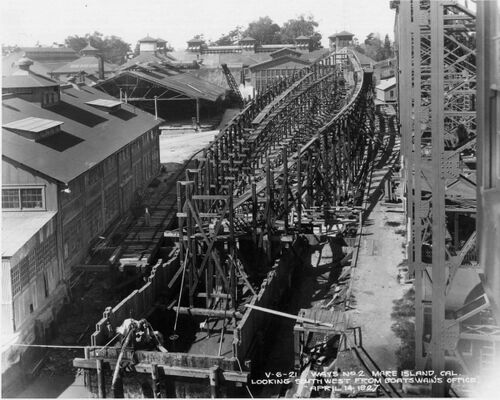
U.S. Navy photo courtesy Darryl Baker
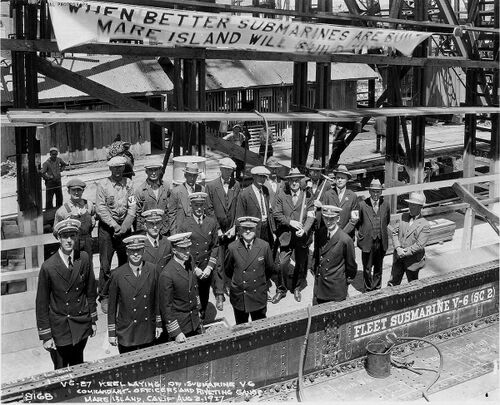
From left to right: Front row; LT J. W. (Duke) Paige, C.C., Ship Supt; CDR E. L. Patch, C.C., Asst. Inside Supervisor, New Work Hull (In general charge of Keel Laying Arrangements); CDR F. J. Wille, Outside Supt.; CAPT C. S. McDowell, Inside Supt.; LCDR W. C. Wade, Asst. Shop Supt.; RADM J. H. Dayton, Commandant Mare Island Navy Yard; CDR E. D. (Bill) Almy, Shop Supt.; J. T. Moroney, Master Shipfitter.
Back Row: Fred Coppo, Rivet Heater; A. P. Schneidewind, Riveter; J. F. Nichelini, Holder-on (all members of regular riveting gang); Honorary Riveting Group: A. L. Luck, Leadingman Shipwirght "Riveter"; W. L. Blackmore, Leadingman Pipefitter "Rivet Passer"; J. E. Moon, Leadingman Machinist "Rivet Heater"; Charles Deaver, Quarterman Riveter "Rivet Heater"; Tom Schofield, Master Rigger & Laborer "Holder-on"; B. A. (Bert) Barr. Quarterman Shipfitter "Riveter"; F. W. Savage, Quarterman Electrician "Rivet Tester"; J. R. Greig, Asst. Shop Supt. "Rivet Tester.
The primary construction method was obviously riveting. But at this time there were experiments underway at Navy yards to incorporate welding. Although not shown in this photo, some non-critical areas such as pipe brackets, superstructure supports, and interior deck joinery were welded.
U.S. Navy photo courtesy Darryl Baker
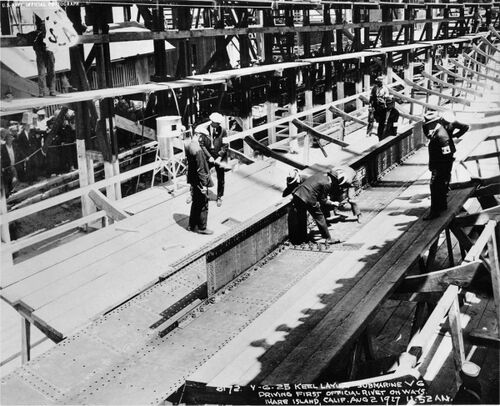
U.S. Navy photo courtesy Darryl Baker
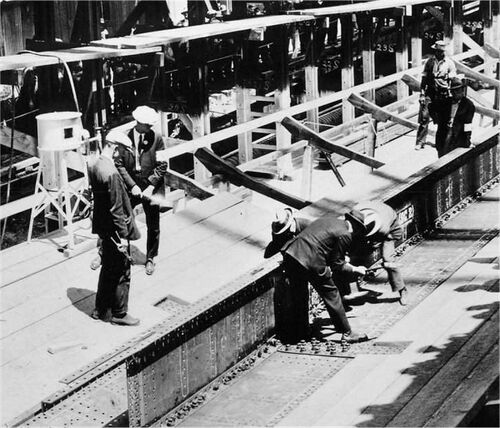
U.S. Navy photo courtesy Darryl Baker
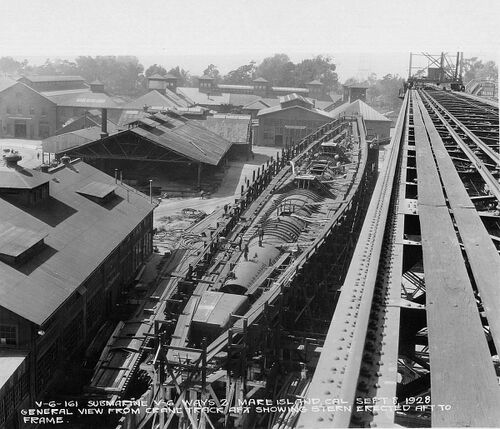
U.S. Navy photo courtesy Darryl Baker
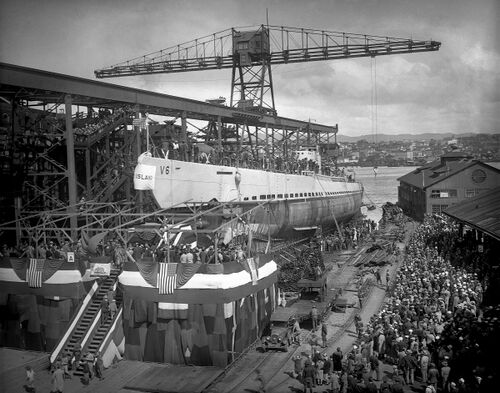
From orignial glass plate negatives in the private collection of Ric Hedman.
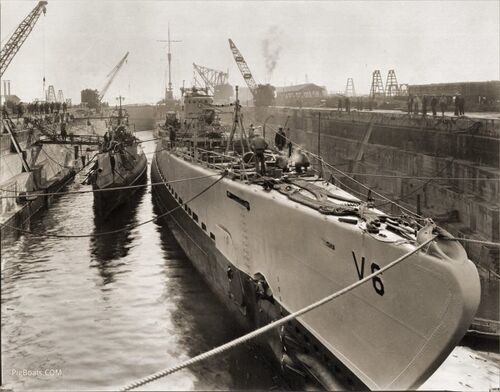
Photo in the private collection of Rid Hedman.
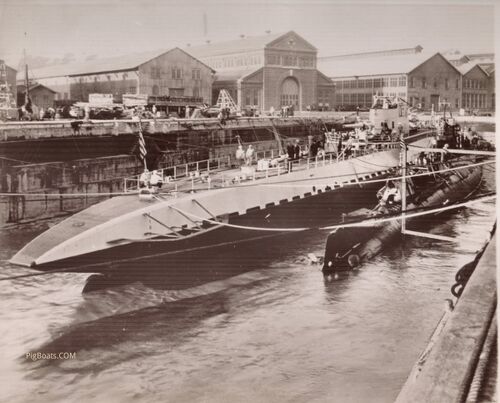
Photo in the private collection of Rid Hedman.
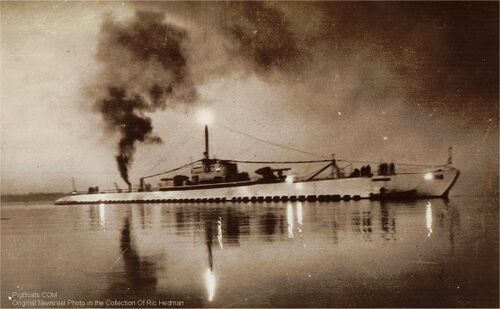
It appears that the V-6 has an oil fired boiler or furnace in her engine room, similar to V-4, as indicated by the heavy black smoke coming from a stack in her after deck. As far as we can tell this is the only photo known to show this feature on V-6. It doesn't seem to be mentioned in any literature about her.
All her running lights and anchor lights seem to be lit and reflecting in the calm pre-dawn waters. The dateline is Seattle, Washington so this may be Puget Sound. The photo is a bit fuzzy probably since the photo was taken from a small boat in the water near the V-6, maybe even from one of her own boats. One of them is seen in the water by the bow planes.
Original Newsreel photo in the private collection of Ric Hedman.

Newspaper Wire photo in the private collection of Ric Hedman.
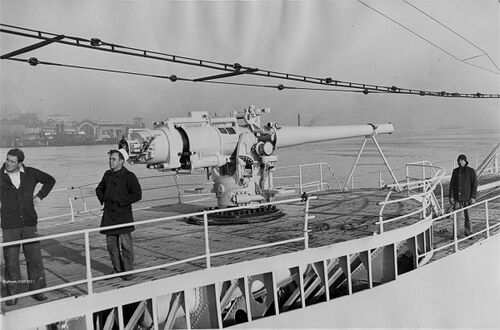
The building in the background is the old St. Georges Ferry Terminal on Staten Island. It burned to the ground in 1946. According to retired Navy Commander Gerald Levey USN, a native of New York; "The ferry terminal is definitely the St George terminal, The ferry, (to the left of the building, twin stacks), is one of the five Dongan Hills class built in 1931. You can date the photo between 1931 and 1946 when the old terminal burned to the ground. It is a rare photo as the three definitive books on the Staten Island Ferries have no decent photos of that terminal as seen from an approaching ferry."
The truly massive size (for a submarine at least) of the 6"/53 caliber guns is very evident in this photo. These were the largest guns ever mounted on a USN submarine.
Photo in the private collection of Ric Hedman.
Page created by:
Ric Hedman & David Johnston
1999 - 2023 - PigBoats.COM©
Mountlake Terrace, WA, Norfolk, VA
webmaster at pigboats dot com

